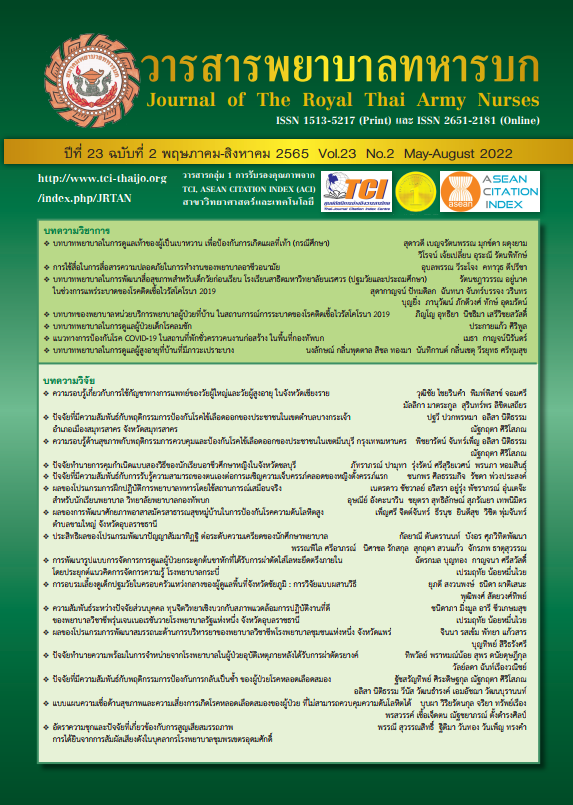Nurse’s Role in Diabetic Foot Care to Prevent Foot Ulcers (Case Study)
Keywords:
Nurse’s Role, Diabetic foot care, Prevent, Foot ulcersAbstract
Diabetic foot ulcers are a major complication in people with diabetes. Which is caused by the degeneration of peripheral nerves and the degeneration of the arteries that together with the pressure on the soles of the feet. This can cause foot ulcers and may cause the patient to have the foot or leg amputated, causing a disability to affect oneself both physically and mentally, causing the family to have an additional burden of care. A burden of society and may be die. Self-management is the key to preventing foot ulcers. If the people with diabetes have good foot care and can self-management with enhanced foot care. Therefore, foot care is very important for people with diabetes. Nurse is an important person who supports self-management in assessing the risk of foot ulcers, for example: assess blood flow, vascular condition, foot examination, the fit and proper fit of shoes. Every time people with diabetes visit the doctor, Assess the knowledge and behavior of diabetic foot care, self-management abilities regarding self-control behaviors of diabetes and follow up to visit service recipients continuously. Therefore, nurse and patient communication are an important proactive tool It must reflect to the service recipients the importance of taking care that is seriously beneficial to the service recipients themselves. In addition to teaching demonstrations and doing it together with the service recipient will help develop the ability to manage themselves more effectively.
Downloads
References
Karuranga S, Malanda B, Saeedi P, Salpea P [Editorial]. IDF diabetes atlas. 9th ed. International Diabetes Federation; 2019: 34-155.
Aekplakorn W [Editor]. Thai National Health Examination Survey V (NHES V). Health System Research Institute. Nonthaburi 2015. (In Thai).
Ogurtsova K, Fernandes R, Huang Y, Linnenkamp U, Guariguata L, Cho NH, et al. IDF Diabete Atlas: Global estimates for the prevalence of diabetes for 2015 and 2040. Diabetes Research and Clinical Practice, 28: 2017 40-50.
Thirapatarapong W, Srisawasdi G. Epidemiology, and direct cost of diabetes–related lower extremity amputations at Siriraj hospital. J Thai Rehabili Med. 2008; 18(2): 65-9.
Ren M, Yang C, Lin DZ, Xiao HS, Mai LF, Guo YC, YanL Effect of intensive nursing education on the prevention of diabetic foot ulceration among patients with high-risk diabetic foot: a follow-up analysis. Diabetes Technology & Therapeutics, 2014 16(9): 576-81.
Diabetes Association of Thailand. (2012). Diabetes clinical practice guideline 2011. Bangkok: Srimuang. (In Thai).
Roning N, Naka K, Chinnawong T. The Effects of Self - Care Promoting Program on Foot Care Behaviors, Foot Conditions and Blood Sugar Levels among Muslim Elderly with Uncontrolled Diabetes Mellitus. Songklanagarind Journal of Nursing. 2021; 41(1): 74-87. (In Thai).
Harutaithaworn R, Nuysri M, Iemsawasdikul W. Effects of a foot care program for risk foot ulcer of type 2 Diabetes Mellitus patients at Samrong Thap District, Surin Province. Thai Journal of Nursing. 2020; 69(4): 21-30. (In Thai).
Pomthong K, Masingboon M, Kunsongkeit W, Factors Influencing Foot Care Behaviors among Type II Diabetes Mellitus at Risk for Diabetic Foot Ulcer. Journal of Nursing and Health Care. 2019; 31(4): 109-118. (In Thai).
Medical Technology Research and Evaluation Institute, Department of Medical Services, Ministry of Public Health. Medical practice guidelines for the prevention and care of diabetic patients with foot complications. Bangkok: Agricultural Cooperative Federation of Thailand Limited; 2013. (In Thai).
Diabetes Association of Thailand, The Endocrine Society of Thailand, National Health Security office. Clinical practice guideline for diabetes 2017. 3rd Pathum Thani: Romyen Media; 2017. (In Thai).
Tiwaskar, M. The Double Trouble: PVD and Peripheral Neuropathy in Diabetes. Journal of The Association of Physicians of India. 2017; 65(5): 11-13.
Moungkum S. Nurses’ Role in Diabetic Foot Care. Journal of The Royal Thai Army Nurses. 2017; 18(Supplement): 1-10. (In Thai).
Palitnonkert A. Factors Related to Diabetic Foot Ulcer of Diabetic Patients in the Hospitals of Primary Health Care Service Network Prapradaeng District, Samutprakarn Province. Association of Private Higher Education Institutions of Thailand Under The Patronage of Her Royal Highness Princess Mahachakri Sirindhorn. 2017;6(1): 56-67. (In Thai).
Kaewdoungto S, Kusuma Na Ayuthya S, Charoenkitkarn, V, Rodphrasert W. Influencing Factors on Foot Care Behavior in Type-2 Diabetes Patients without History of Foot Ulcer. Journal of Nursing, Siam University. 2016;17(33): 31-46. (In Thai).
Nonpanya U, Terathongkum S, Lininger J. Effects of Self-Efficacy Enhancement of Foot Care Program on Foot Care Behavior and Insensate Foot among Persons with Type 2 Diabetes. Thai Journal of Nursing and Midwifery Practice. 2020; 7(2): 76-91. (In Thai).
Moungkum S, Duongpaeng S, Kunsongkeit W. Factors influencing macrovascular complications among persons with type 2 diabetes. The Journal of Faculty of Nursing Burapha University 2017; 25(2) Inpress. (In Thai).
Mangklakeeree N, Senachai N, Panput A. Diabetes Management in Working Age Group: The Challenging for Nurse Practitioners. Journal of the Royal Thai Army Nurses 2021; 22(3): 19-27. (In Thai).
WHO guidelines on physical activity and sedentary behavior. Adults and Older Adults with Chronic Corditions (aged 18 years and older). 25 November 2020: 17-34.
Medical Technology Research and Evaluation Institute, Ministry of Public Health. Guidelines for the prevention and care of diabetic patients with foot complications. Bangkok: Agricultural Cooperatives Association of Thailand; 2013:30
Downloads
Published
How to Cite
Issue
Section
License
Copyright (c) 2022 Journal of The Royal Thai Army Nurses

This work is licensed under a Creative Commons Attribution-NonCommercial-NoDerivatives 4.0 International License.
บทความหรือข้อคิดเห็นใดใดที่ปรากฏในวารสารพยาบาลทหารบกเป็นวรรณกรรมของผู้เขียน ซึ่งบรรณาธิการหรือสมาคมพยาบาลทหารบก ไม่จำเป็นต้องเห็นด้วย
บทความที่ได้รับการตีพิมพ์เป็นลิขสิทธิ์ของวารสารพยาบาลทหารบก
The ideas and opinions expressed in the Journal of The Royal Thai Army Nurses are those of the authors and not necessarily those
of the editor or Royal Thai Army Nurses Association.






